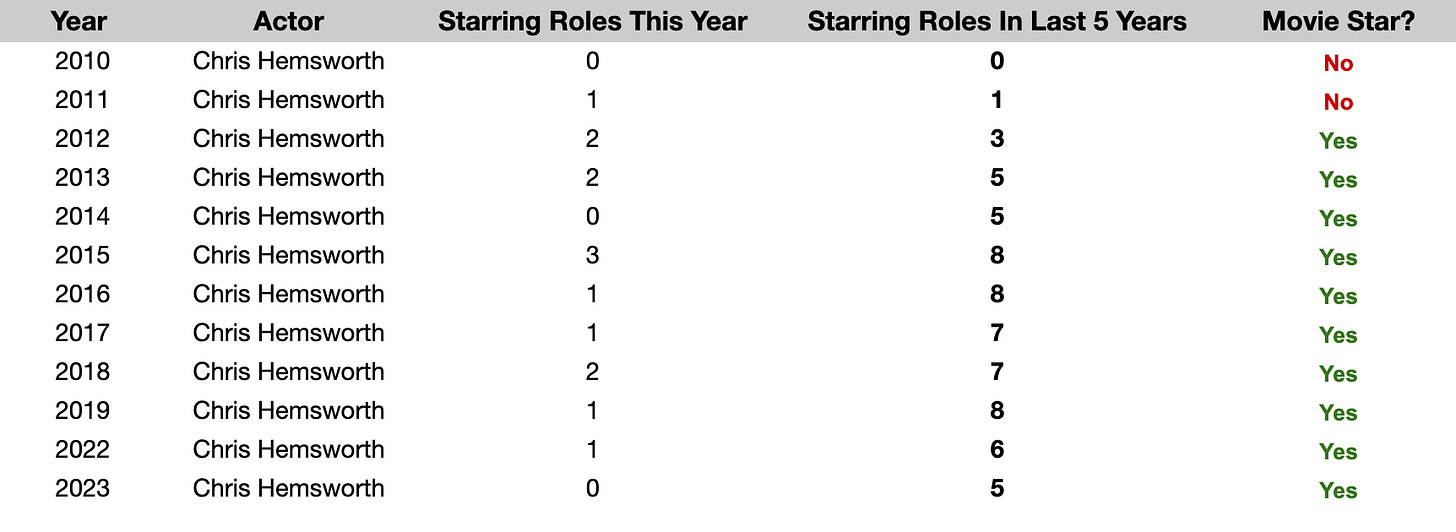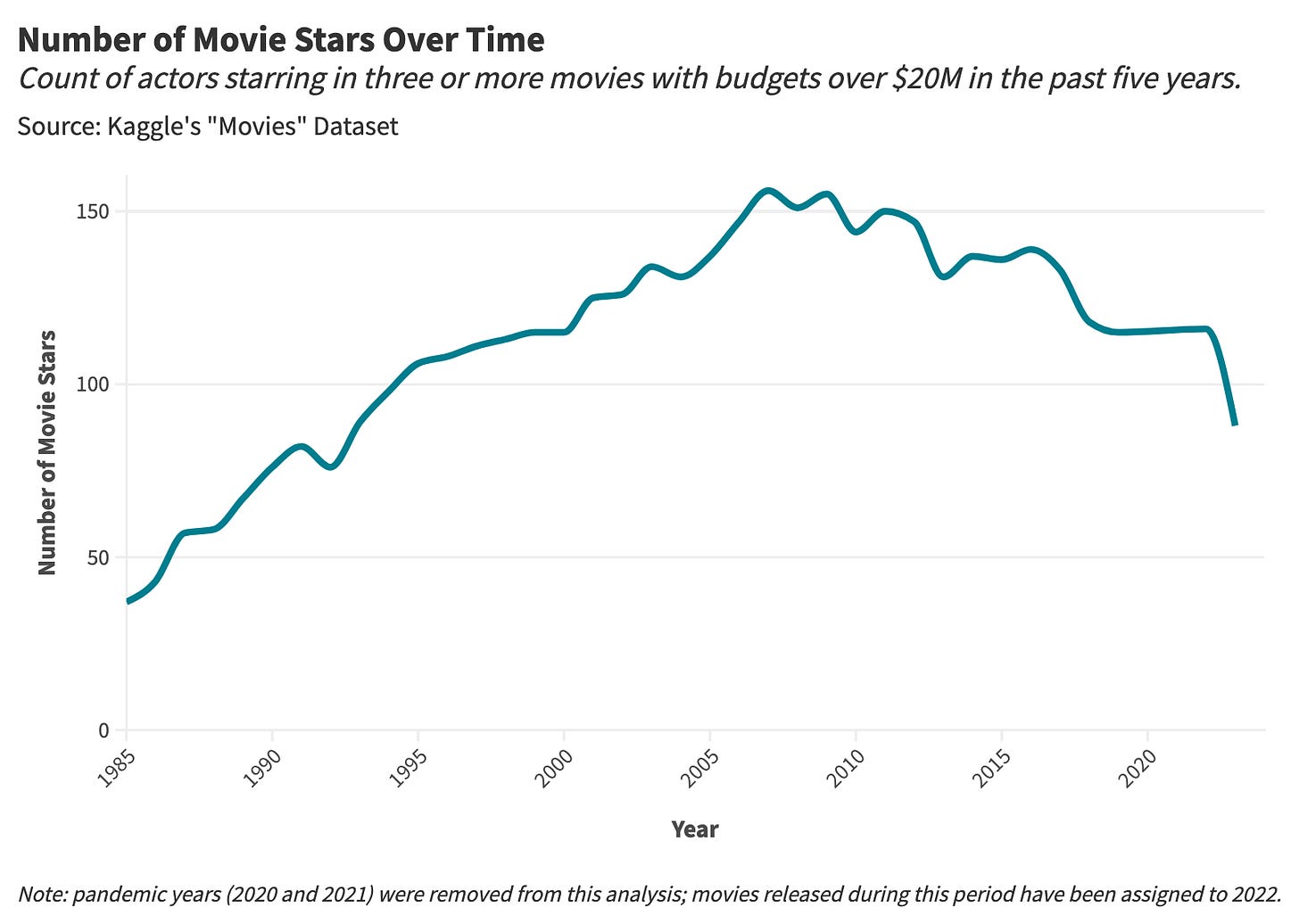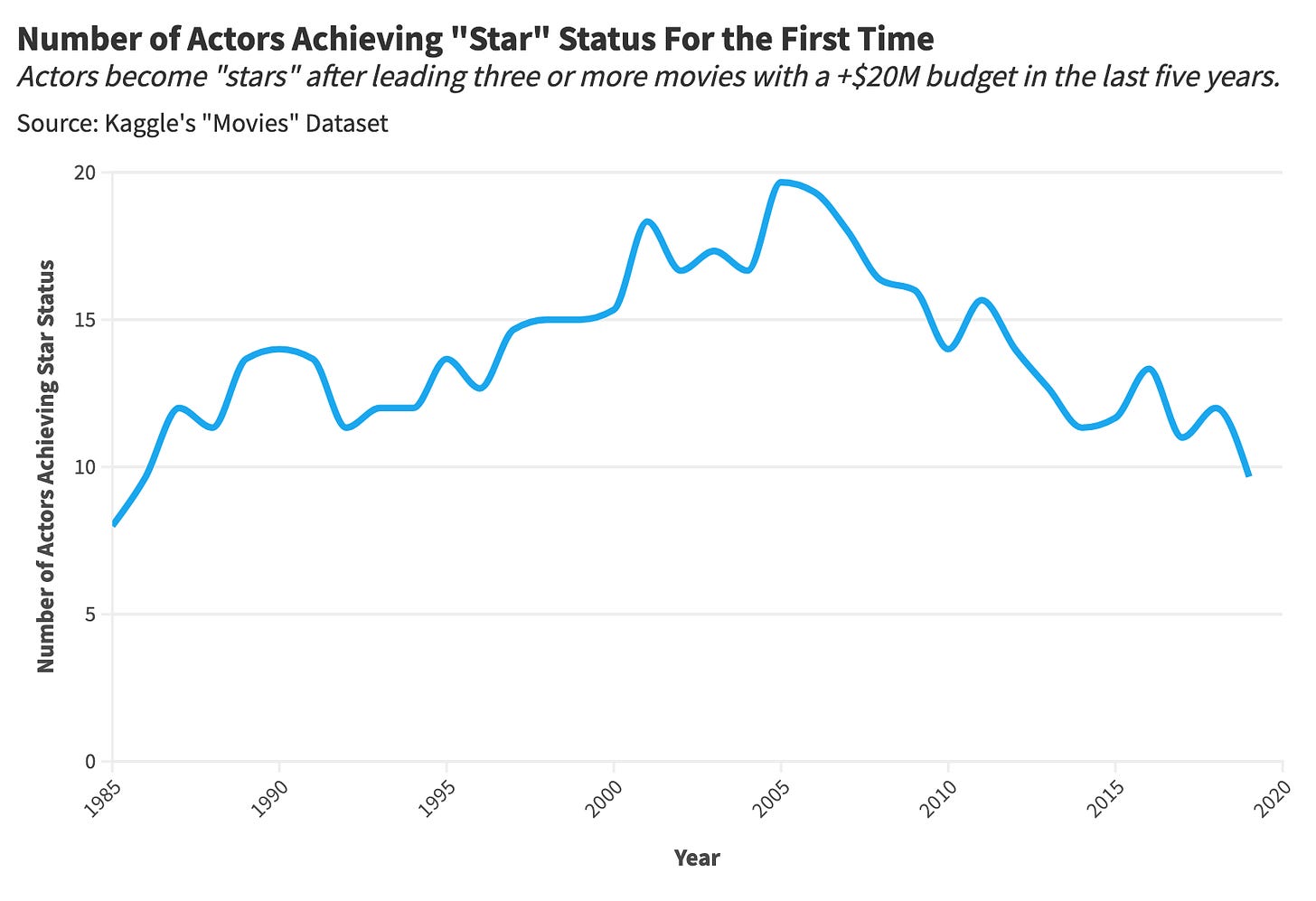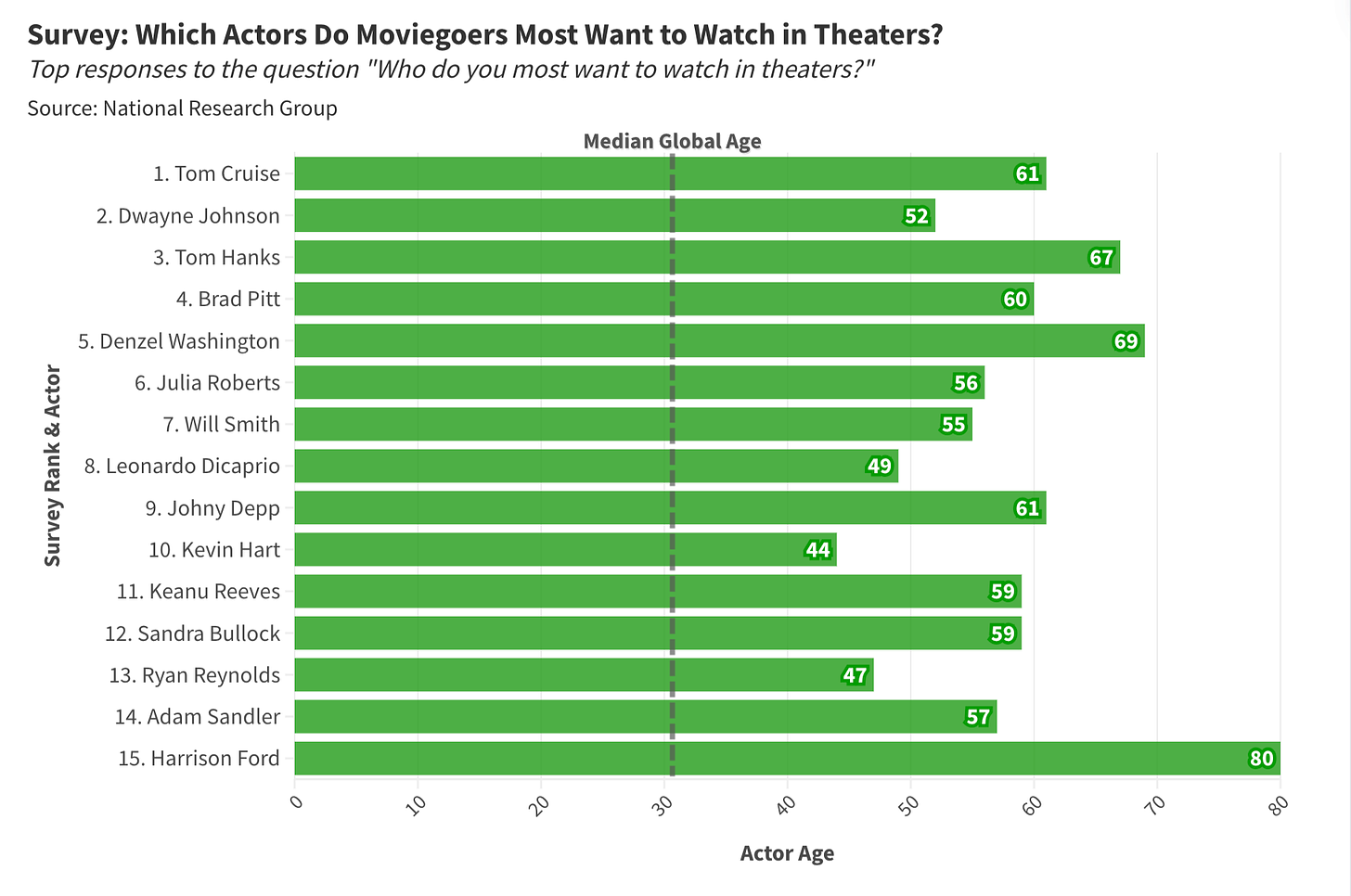- Stat Significant
- Posts
- Is Movie Stardom in Decline? A Statistical Analysis
Is Movie Stardom in Decline? A Statistical Analysis
Are movie stars a relic of the past?

Top Gun: Maverick (2022). Credit: Paramount Pictures.
Intro: How Movie Stardom Killed the Undershirt
In the summer of 1934, a seismic shift in American fashion began, not in global fashion capitals like New York and Milan, but in ordinary movie theaters worldwide—at least according to Hollywood lore. As the story goes, it was during Frank Capra's screwball comedy It Happened One Night that movie star Clark Gable performed a simple act that would (allegedly) change men's fashion forever: he took his shirt off (on-screen!). Within weeks, clothing retailers reported a steep drop in undershirt sales as men nationwide ditched their extra layers in favor of bare-chestedness.

It Happened One Night (1934). Credit: Columbia Pictures
Now, you may ask, "Is this Clark Gable story true?" Well, the answer to this question is, "Who knows?!" That said, Snopes, the internet's leading myth-debunker, found this legend significant enough to dedicate a 900-word write-up to the Gable-chest phenomenon (which they were unable to prove or disprove). Whether It Happened One Night actually caused a decline in undershirt sales will remain forever unknown. Yet, the fact that this myth has persisted for nearly a century is a testament to Gable's star power in the early 20th century and the conceivable impact of movie stardom during this period.
Fast forward nearly 90 years, and movie stardom is now (allegedly) in crisis. Digital media outlets, always in search of a new catastrophe, have begun interrogating a perceived decline in actors who qualify as "box office draws":
2019: Is the era of the movie star over? (BBC)
2022: Twilight of the A-list: has the 21st century killed off the movie star? (The Guardian)
2023: Are we witnessing the death of movie stars? (NPR)
Sure, these articles are compelling, especially if your goal is to be in a slightly worse mood post-read, but are they accurate? Is the era of the movie star over?
So today, we'll attempt to debunk (or support) claims of declining movie stardom and pinpoint the idiosyncracies of modern celebrity.
Methodology: Defining Movie Stardom
How do you quantify cultural capital? Can a person's hold over popular imagination be translated into numbers? In short, the answer is yes (or at least I think so).
Movies are a capital-intensive investment in search of an outsized return. A leading actor or actress is the most visible face attached to this venture and should prove additive to a film's bottom line. The bigger the movie, the more a studio trusts its star to boost (or at least not harm) the project's box office. If you're making a $100M movie, you're not going to cast Kevin Spacey or James Franco (who could alienate potential viewers); you'll invest $100M in a vehicle for Tom Cruise or Denzel Washington.
Using this logic, we'll define movie stardom based on the following criteria:
Number of Leading Roles in Bigger-Budget Projects: An actor or actress is considered a star if they have had a leading role in at least three movies within the past five years. A film will only be counted if it has an inflation-adjusted budget of $20 million or greater.
This five-year time span enables actors to take on projects in other mediums, like TV or theater, while still maintaining a foothold in the film industry.
Criteria for a “Leading” Role: A role is considered "starring" if the actor or actress is credited in the first or second slot of the film's cast list.
Assessment Timeframe: A person can gain or lose movie star status over time—this designation is assessed on a rolling basis (yearly).
No Animated Films: Animated film credits have been excluded. Nobody cares that Chris Pratt voiced Garfield.
Accounting for COVID: COVID years (2020 and 2021) will be excluded from this analysis, and films released during this period will be reassigned to 2022. This ensures that the dip in theatrical releases during the pandemic will not count against an actor's filmography.
As an example, let's examine the career of Chris Hemsworth.
In 2010, Chris Hemsworth was a relatively unknown Australian actor, having never starred in a movie with a sizable budget. In 2011, Hemsworth debuted as Thor, and by 2012, he had starred in three major projects, thus earning him star status. Since then, Hemsworth has continued starring in big-budget projects, mostly Marvel movies, which enables him to retain his movie star designation.

I acknowledge that defining movie stardom attempts to quantify a subjective phenomenon, which makes this benchmark worthy of debate. At the same time, we have to pick some sort of criteria, and these are mine. If Snopes wants to mount an investigation into my methodology, then so be it.
Is Movie Stardom in Decline?
When we chart a rolling count of movie stars over time, we see a distinct peak in stardom in the mid-2000s, with over 150 actors qualifying as "stars" during this period. Since 2005, the number of marque film actors has declined, even after adjusting our methodology to account for the pandemic slowdown.

Some explanations for this decline are obvious, such as the rise of TV, increased use of CGI and animated characters, and intellectual property overwhelming superstardom. Other factors are less straightforward, like the fragmentation of our attention across numerous platforms (theaters, streaming, social media, etc), a boom in non-fiction storytelling, and the consolidation of film industry bets on established commodities (a.k.a. older actors). Collecting and maintaining cultural capital in a fragmented attention economy marked by risk aversion and boundless content is, no doubt, more challenging.
Indeed, when we examine a rolling count of actors achieving star status for the first time, we observe a pronounced decline beginning in 2006.

This data piqued my curiosity about the current state of film celebrity. Are today's movie stars mostly a product of the 1990s and 2000s? Which actors still have the power to attract audiences in an industry incapable of mythologizing new figures?
Need Help with a Data Project?

Enjoying the article thus far and want to chat about data and statistics? Need help with a data or research project? Well, you’re in luck because Stat Significant offers data science consulting services. Reach out if you’d like to learn more!
Email [email protected]
The Whackiness of Modern Movie Stardom
In late 2023, an extensive survey conducted by the National Research Group asked consumers, "Which actor do you most want to see in theaters?" The results were astonishing: not a single actor in the top 15 was under the age of 44. Unsurprisingly, these findings threw the entertainment industry into a (minor) existential crisis.

Arguably, the most surprising aspect of these results was the absence of up-and-coming prospects like Zendaya and Timothée Chalamet, actors who have proven box office success (albeit in mainstream intellectual property like Wonka and Spider-Man), with Zendaya ranking 49th and Chalamat falling to 94th. People paid to see Dune, Wonka, and Spider-Man: No Way Home and likely cultivated some sort of emotional relationship with these actors—so how is Harrison Ford still a bigger box office draw? There is nothing inherently wrong with an older leading man, but how can Ford's box office success in the 1980s and 1990s trump hits from the 2020s?
Another bizarre feature of this list is the presence of two actors that media outlets have presumed to be "canceled." As of late last year, post-"slap" Will Smith and post-trial Johnny Depp still reign as box office draws. This sentiment was affirmed by Smith's recent star turn in Bay Boys: Ride or Die, which has grossed over $300M to date. It's almost as if 2005 serves as a point of no return for movie stardom. Depp's Pirates of the Caribbean and Smith's Independence Day hit before this time, so their celebrity is assured, while those attempting to build careers after this point struggle to accumulate cultural capital.
As a result, the average age of leading actors has gradually risen over the last twenty years.

Looking at the breakout of leading actors by age group, we find a growing share of starring performances come from actors in their 50s and 60s.

Last year, in the run-up to Mission Impossible: Dead Reckoning, Tom Cruise proclaimed his desire to continue making Mission Impossible movies well into his 80s, just like Harrison Ford. The media took this proclamation and reduced the story to clickbait. Yet Cruise's statement challenges Hollywood's complicated relationship with age.
A fundamental tension exists between an actor's brand and seniority. Personally, I love Tom Cruise movies and would enjoy seeing him jump out of planes, fly planes, or explode planes for as long as humanly possible. Still, at some point, Cruise's heroics will have to end, right? Surely, someone will take Tom Cruise's place.
If the days of monocultural icons like Tom Cruise are gone, then what will movie stardom look like in 2070? Will humans be replaced by CGI Godzilla and animated Minions? Will I enjoy death-defying stunts performed by a Tom Cruise hologram?
Final Thoughts: Does Stardom Matter?

Hit Man (2023). Credit: Netflix.
Multiple times throughout my research, I was struck by an existentially pernicious thought: Does movie stardom actually matter? Does any of this actually matter? 🙉 Sure, it's fun to quantify things, but does the erosion of (real-life) hero worship have some greater meaning?
Ultimately, this made me question why "stardom" or celebrity exists in the first place. Why did humans evolve to trust and valorize individuals they may have never met? What is the social benefit of idolization?
One common explanation for our fixation with celebrity stems from a school of thought known as Uses and Gratification Theory. First proposed in the late 1970s, this theory posits that individuals seek entertainment that satisfies latent needs and desires, using media representations for information-gathering, personal identity, social integration, and social interaction.
So what does Uses and Gratification Theory look like in practice? Let's try applying this framework to the mainstream action films of the 1980s. According to this line of thought, classic action movies like Rambo, Commando, and Predator satisfied a collective need for indomitable heroes who personified physical strength, patriotic resilience, and moral clarity, providing escapism and reassurance during a time of Cold War anxieties and shifting cultural values (or at least that's my best guess). For some reason, the cultural milieu of the 1980s led to a demand for big muscle men acting as murderous machine-gun-wielding vigilantes, and this desire was satiated by Schwarzenegger, Stallone, Chuck Norris, and Steven Segal. Aside from a few nuances, these actors and films were surprisingly homogeneous, consistently adhering to the same formula.
Fast forward to today, a world defined by "micro-celebrity"—a term I find both fitting and irksome. Rather than idolizing a single character that exists as a composite of various needs and values, we follow five micro-celebrities of highly nuanced appeal.
Now consider the release of Hit Man this past month, a critically acclaimed comedy that should (ostensibly) affirm Glen Powell's ascension to movie stardom. Powell has been a key player in numerous blockbusters over the past few years, including Top Gun: Maverick, Anyone But You, and the upcoming Twisters. In 1999, this guy is a full-blown movie star. In 2024, Hit Man is released on Netflix, where it is passively consumed whilst scrolling on Instagram, and promptly memory-holed. People may never remember watching this movie in the first place. Powell's stock rises ever so slightly, and we move on with our lives. To pique our attention, Powell must be more memorable than CGI apes, animated emotions (like anxiety!), reality TV stars, other tiles on the Netflix home screen, political zealots, and TikTok.
Glen Powell cannot single-handedly crush the undershirt market—no one can. Society’s appraisal of undershirts is influenced by a grab-bag of content, such as:
Season 7 of "Too Hot to Handle"
Season 3 of "The Bear"
An Instagram hashtag (#FreeTheChest)
Man-o-sphere YouTubers praising the merits of meat and bare chests
And, if you're so inclined, Glen Powell's constant shirtlessness in Anyone But You
Or, as crazy as it sounds, you don't have to rely on any of these figures for guidance—you can simply make your own decisions.
Thanks for reading Stat Significant! Subscribe for free to receive new posts and support my work.
Want to chat about data and statistics? Have an interesting data project? Just want to say hi? Email [email protected]